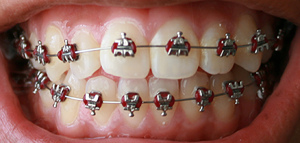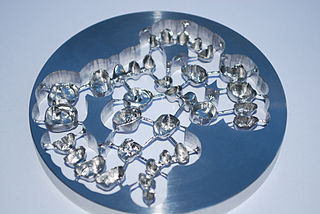Related Research Articles

Stainless steel is an alloy of iron that is resistant to rusting and corrosion. It contains at least 11% chromium and may contain elements such as carbon, other nonmetals and metals to obtain other desired properties. Stainless steel's resistance to corrosion results from the chromium, which forms a passive film that can protect the material and self-heal in the presence of oxygen.

Stainless steels can be classified by their crystalline structure into five main types: austenitic, ferritic, martensitic, duplex, and precipitation hardened. Martensitic stainless steel is a specific type of stainless steel alloy that can be hardened and tempered through multiple ways of aging/heat treatment.
In modern Western body piercing, a wide variety of materials are used. Some cannot be autoclaved, and others may induce allergic reactions, or harbour bacteria. Certain countries, such as those belonging to the EU, have legal regulations specifying which materials can be used in new piercings.
AL-6XN is a type of weldable stainless steel that consist of an alloy of nickel (24%), chromium (22%) and molybdenum (6.3%) with other trace elements such as nitrogen.
Titanium alloys are alloys that contain a mixture of titanium and other chemical elements. Such alloys have very high tensile strength and toughness. They are light in weight, have extraordinary corrosion resistance and the ability to withstand extreme temperatures. However, the high cost of both raw materials and processing limit their use to military applications, aircraft, spacecraft, bicycles, medical devices, jewelry, highly stressed components such as connecting rods on expensive sports cars and some premium sports equipment and consumer electronics.

An archwire in orthodontics is a wire conforming to the alveolar or dental arch that can be used with dental braces as a source of force in correcting irregularities in the position of the teeth. An archwire can also be used to maintain existing dental positions; in this case it has a retentive purpose.
Alloy 20 is an austenitic stainless steel containing less than 50% iron developed for applications involving sulfuric acid. Its corrosion resistance also finds other uses in the chemical, petrochemical, power generation, and plastics industries. Alloy 20 resists pitting and chloride ion corrosion, better than 304 stainless steel and on par with 316L stainless steel. Its copper content protects it from sulfuric acid. Alloy 20 is often chosen to solve stress corrosion cracking problems, which may occur with 316L stainless. Alloy of the same name with the designation "Cb-3" indicates columbium stabilized.
Marine grade stainless alloys typically contain molybdenum to resist the corrosive effects of NaCl or salt in seawater. Concentrations of salt in seawater can vary, and splash zones can cause concentrations to increase dramatically from the spray and evaporation.

Intergranular corrosion (IGC), also known as intergranular attack (IGA), is a form of corrosion where the boundaries of crystallites of the material are more susceptible to corrosion than their insides.

Austenitic stainless steel is one of the five classes of stainless steel by crystalline structure. Its primary crystalline structure is austenite and it prevents steels from being hardenable by heat treatment and makes them essentially non-magnetic. This structure is achieved by adding enough austenite stabilizing elements such as nickel, manganese and nitrogen. The Incoloy family of alloys belong to the category of super austenitic stainless steels.

The SAE steel grades system is a standard alloy numbering system for steel grades maintained by SAE International.
Zeron 100 is a super duplex stainless steel developed by Rolled Alloys. The alloy has excellent corrosion resistance combined with high strength. It typically contains 25% chromium and 7% nickel and 3.6% molybdenum along with copper and tungsten additions. Zeron 100 has a 50–50 austenitic–ferritic structure. It also has greater resistance to chloride pitting, crevice corrosion and stress corrosion cracking than exhibited by the standard 300 series stainless steels.

Cobalt-chrome or cobalt-chromium (CoCr) is a metal alloy of cobalt and chromium. Cobalt-chrome has a very high specific strength and is commonly used in gas turbines, dental implants, and orthopedic implants.

SAE 304 stainless steel is the most common stainless steel. The steel contains both chromium and nickel metals as the main non-iron constituents. It is an austenitic stainless steel. It is less electrically and thermally conductive than carbon steel. It is magnetic, but less magnetic than steel. It has a higher corrosion resistance than regular steel and is widely used because of the ease in which it is formed into various shapes.
SAE 310S stainless steel is the low carbon version of 310 and is suggested for applications where sensitisation, and subsequent corrosion by high temperature gases or condensates during shutdown may pose a problem.
SAE Type 630 stainless steel is a grade of martensitic precipitation hardened stainless steel. It contains approximately 15–17.5% chromium and 3–5% nickel, as well as 3–5% copper. The name comes from the chemical makeup which is approximately 17% chromium and 4% nickel. SUS630 is the same as 17-4PH, and they both refer to the same grade.

SAE 316L grade stainless steel, sometimes referred to as A4 stainless steel or marine grade stainless steel, is the second most common austenitic stainless steel after 304/A2 stainless steel. Its primary alloying constituents after iron, are chromium, nickel (10–12%) and molybdenum (2–3%), with small (<1%) quantities of silicon, phosphorus & sulfur also present. The addition of molybdenum provides greater corrosion resistance than 304, with respect to localized corrosive attack by chlorides and to general corrosion by reducing acids, such as sulfuric acid. 316L grade is the low carbon version of 316 stainless steel. When cold worked, 316 can produce high yield and tensile strengths similar to Duplex stainless grades.
X46Cr13 is the European Norm name for a common martensitic stainless steel with the numeric name 1.4034. It is equivalent to American Iron and Steel Institute standard 420C. It has the highest carbon content of the SAE 420 series.
Ferritic stainless steel forms one of the five stainless steel families, the other four being austenitic, martensitic, duplex stainless steels, and precipitation hardened. For example, many of AISI 400-series of stainless steels are ferritic steels. By comparison with austenitic types, these are less hardenable by cold working, less weldable, and should not be used at cryogenic temperatures. Some types, like the 430, have excellent corrosion resistance and are very heat tolerant.
References
- ↑ Stainless Surgical Instruments. Boston Career Institute (BCI Inc.). YouTube (video). Brookline. Archived from the original on 12 December 2021. Retrieved 4 August 2018. Martensitic and austenitic are only described as 400 and 300 series.
- ↑ "Differences between 316 and 316L Stainless Steel". Penn Stainless. Retrieved 8 May 2019.
- ↑ "BioDur® 316LS Stainless". Carpenter. Retrieved 8 May 2019.
- ↑ "Jewelry Standards". Association of Professional Piercers.
- ↑ Thomas, P.; Schuh, A.; Ring, J.; Thomsen, M. (2007). "Orthopädisch-chirurgische Implantate und Allergien" [Orthopedic surgical implants and allergies]. Der Orthopäde (in German). 37 (1): 75–88. doi:10.1007/s00132-007-1183-3. PMID 18210082. S2CID 7008822.
- ↑ Thomas, P.; Thomsen, M. (2010). "Implantatallergien" [Implant allergies]. Der Hautarzt (in German). 61 (3): 255–262, quiz 263–264. doi:10.1007/s00105-009-1907-x. PMID 20204719.
- ↑ "Properties of an Essentially Nickel-Free Stainless Alloy for Medical Implants". Carpenter. Retrieved 8 May 2019.
- ↑ "Standard Specification for Chemical Passivation Treatments for Stainless Steel Parts". ASTM. Retrieved 8 May 2019.
- ↑ "ASTM F899 - Standard Specification for Wrought Stainless Steels for Surgical Instruments". ASTM. Retrieved 8 May 2019.